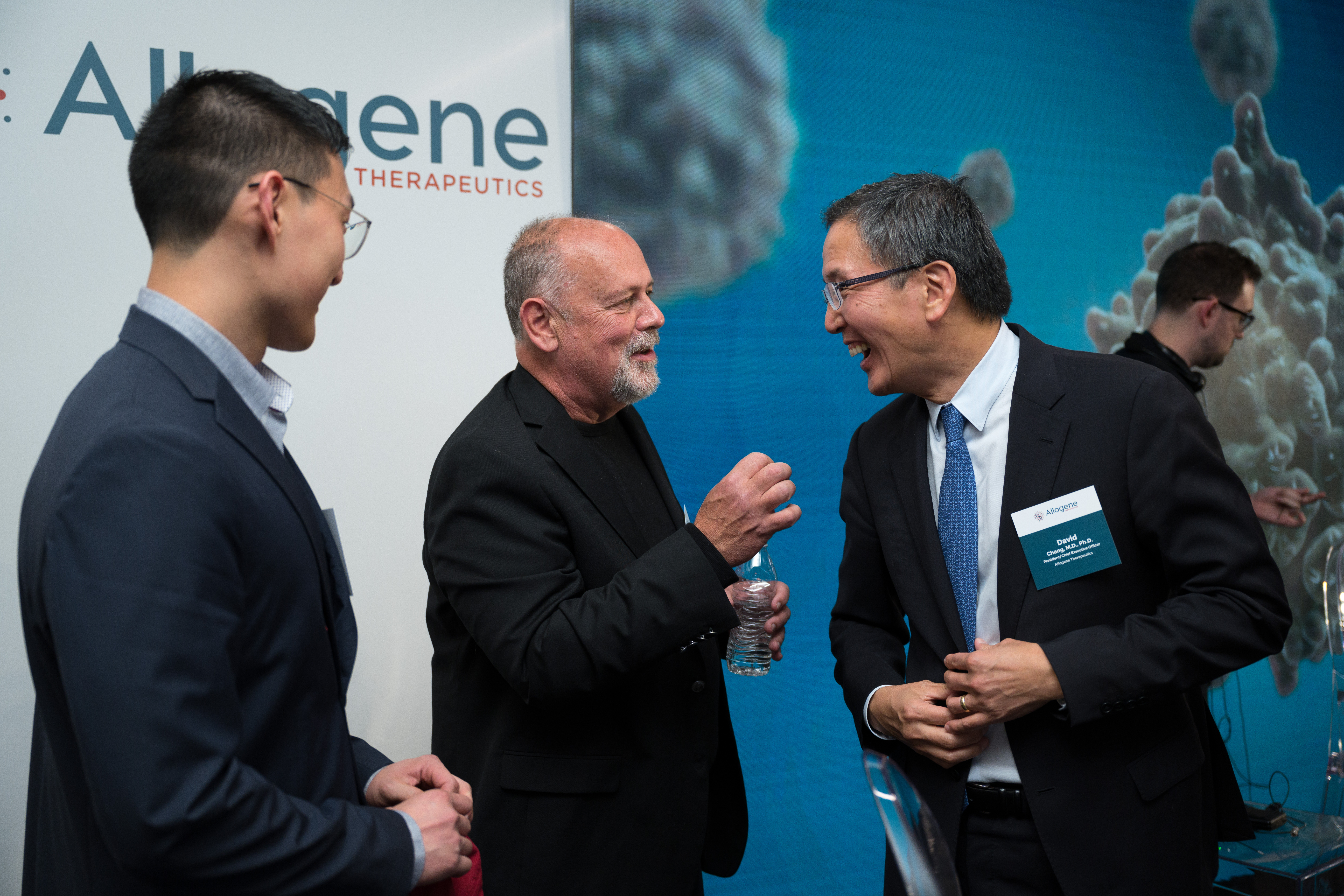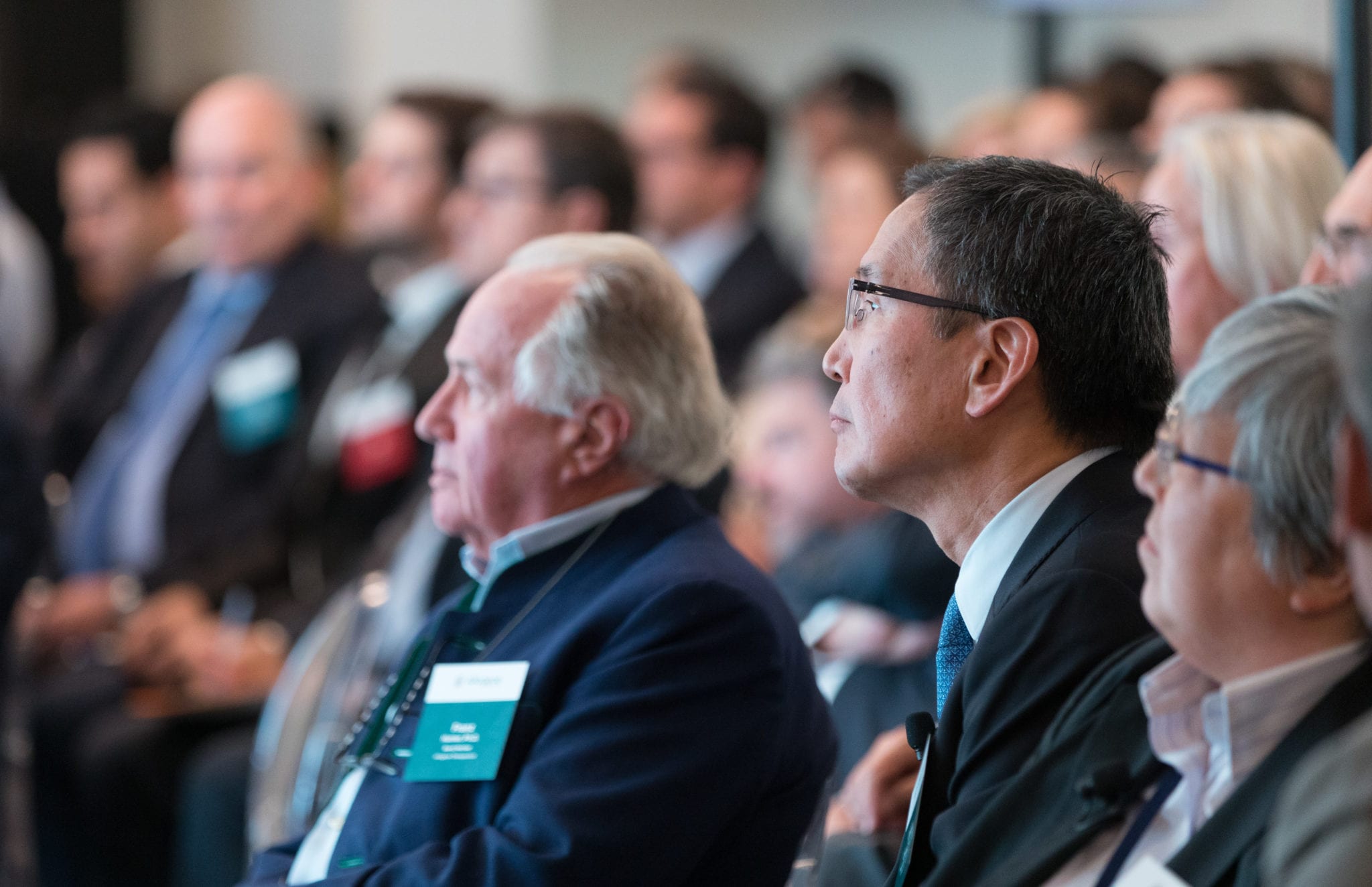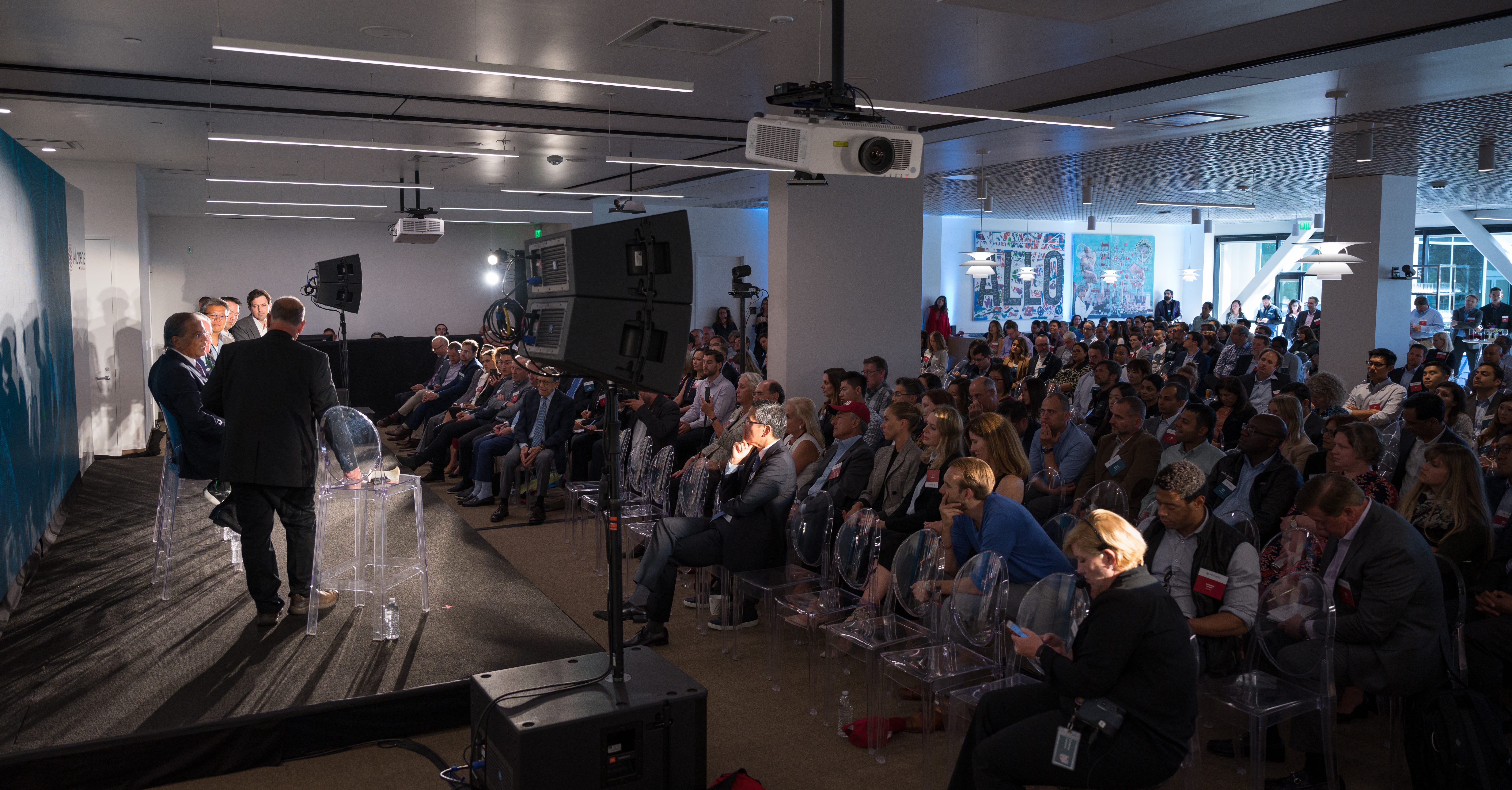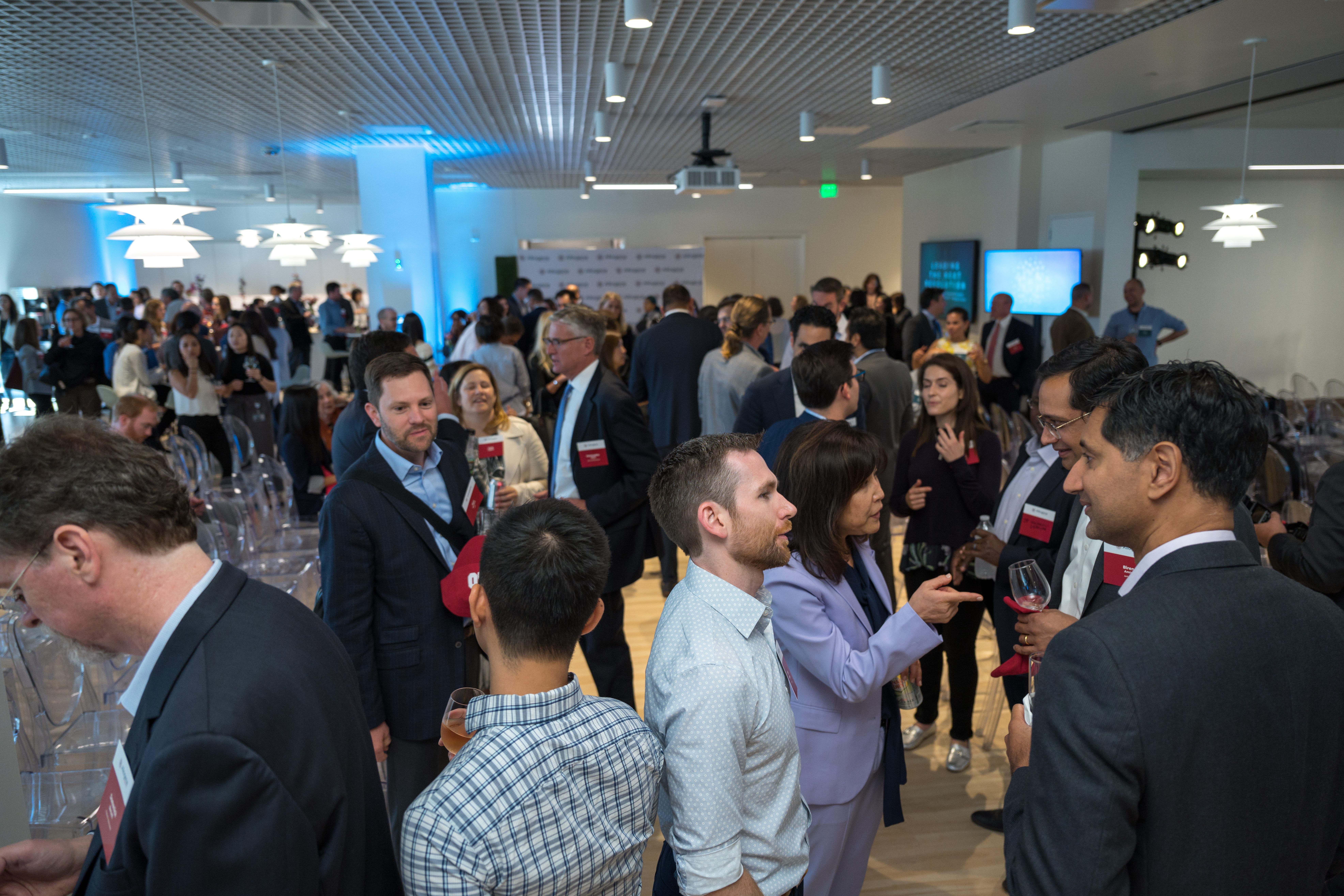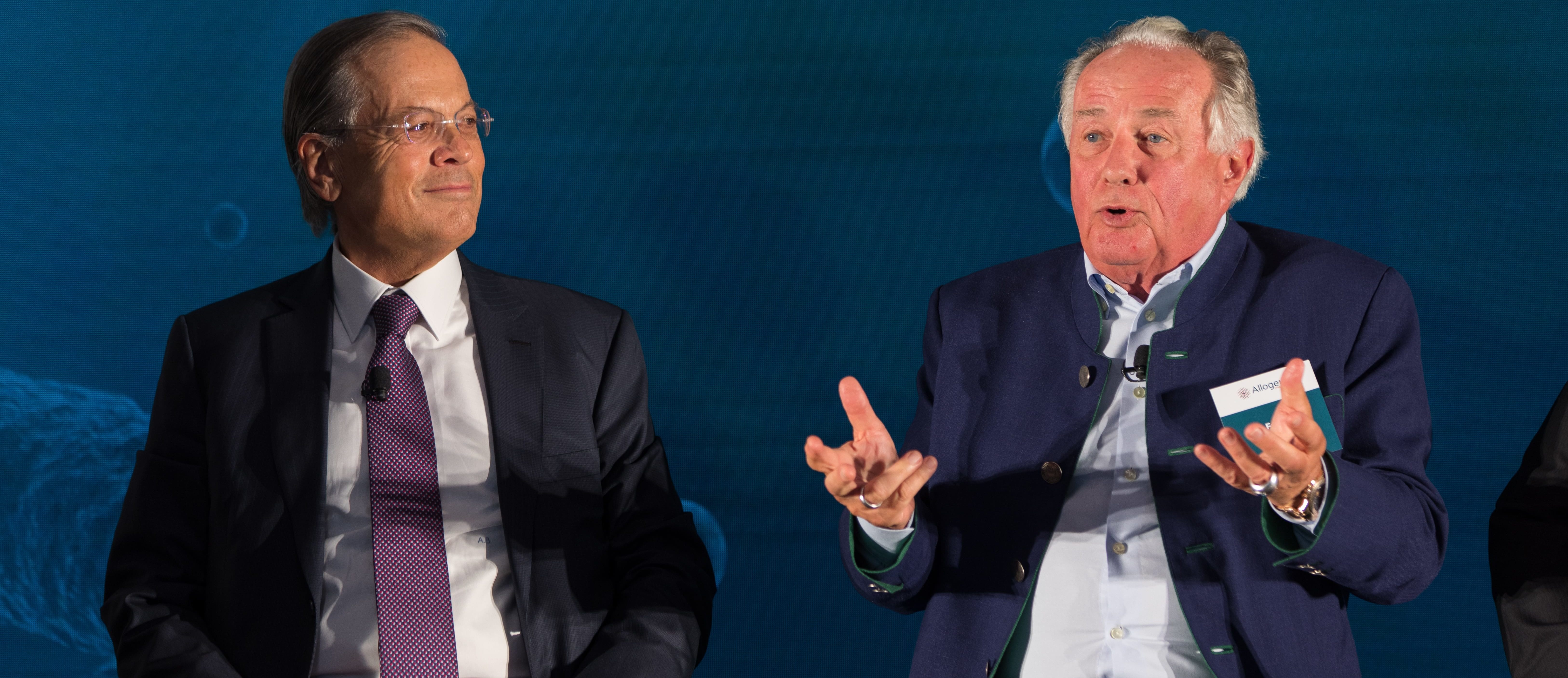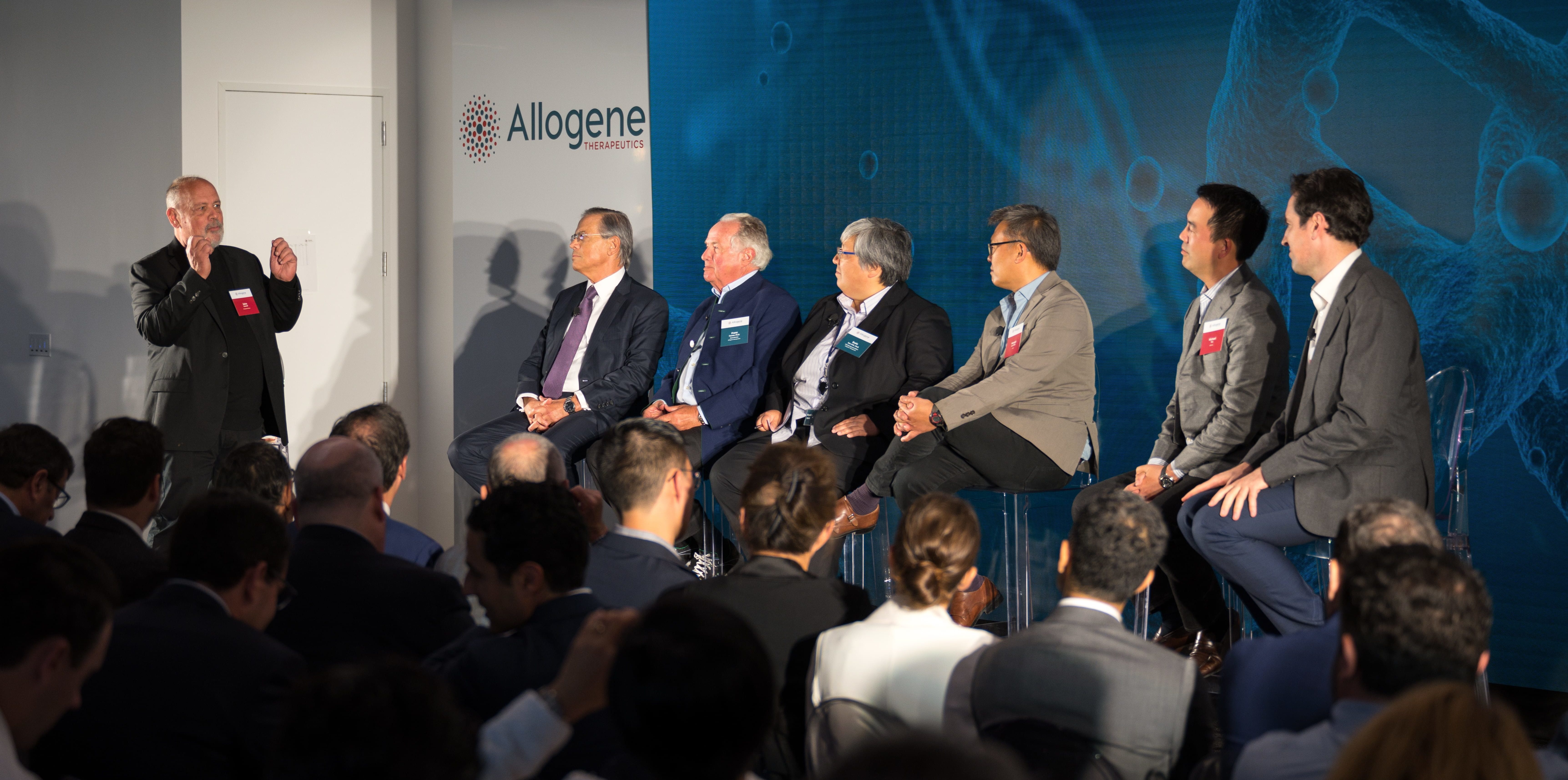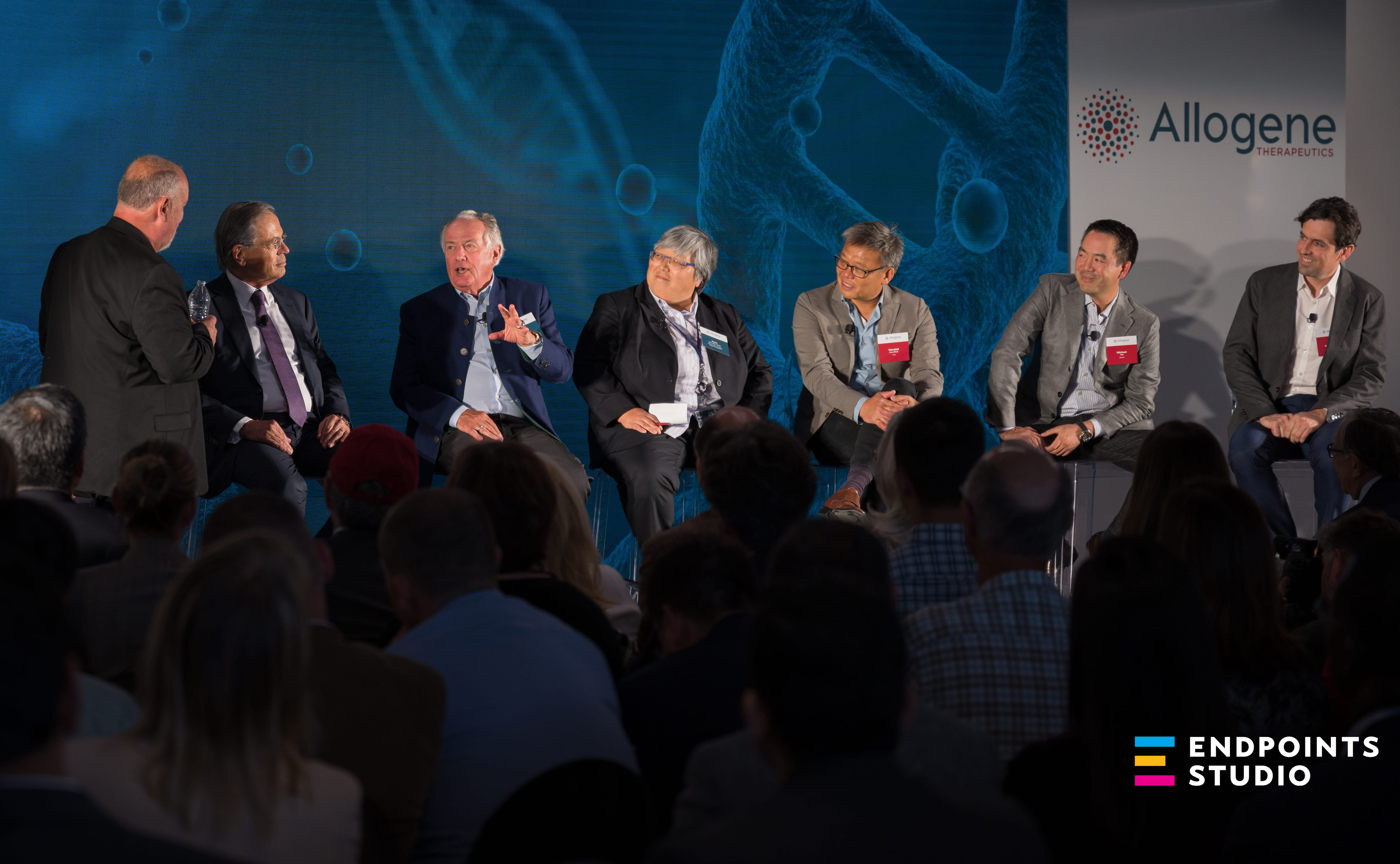
The next 10 years: Where is biotech headed?
The last 10 years have seen a revolution in drug development. Timelines have shortened, particularly in oncology. Regulators have opened up. Investment has skyrocketed. China became a player. Biotechs have multiplied as gene and cell therapy has exploded — offering major new advances in the way diseases are treated, and sometimes cured.
So where are we headed from here? I journeyed out to San Francisco in September to discuss the answer to that question at Allogene’s open house. If the last 10 years have been an eye-opener, what does the next decade hold in store?
I pitched that to a diverse panel, including Arie Belldegrun, the executive chairman of Allogene, along with ex-Roche CEO Franz Humer, UCSF professor and entrepreneur Wendell Lim, Allogene development chief Susie Jun, Jefferies’ prolific Michael Yee and Ziad Bakri, who manages the health sciences fund at T. Rowe Price.

All of the news, delivered with full-text to your inbox. For professionals discovering, developing, and marketing biopharmaceutical drugs.
Take it away.
— John Carroll
This discussion has been lightly edited. Photography by Jeff Rumans, Endpoints News.
Arie Belldegrun, Franz Humer, Wendell Lim, Michael Yee, Ziad Bakri.
Click on the image to see the full-sized version
John Carroll: So, great crowd. Wow. Interesting coming out here. I always love to come to California. It’s a different kind of a place. I’m based in Vermont, and I just do everything out of Vermont regardless of where it may be around the world it’s happening. And everything is happening faster and faster and faster. I’ve been covering the field for 17 years. I was in the San Francisco Museum of Modern Art on Sunday, and there’s a landscape artist called Piazzoni, who was an artist here in the early 20th century. And somebody asked him what his religion was. He said, ‘I think it’s California.’ Which is great, because to me I thought that was a wonderful way to express a certain spiritual connection with the place.
And to me, my connection with California is that this is a state of possibilities. A place where things are happening. A place where there’s a very forward-looking approach to everything that’s going on right now, particularly in biotechnology. So my task here is really kind of a simple one, but at the same time very provocative as well, I hope. Looking at where we’re headed. Not short term necessarily, but 10 years down the line. If you look 10 years back, 2009, you couldn’t do an IPO, no matter what you tried to do. There were no biotech IPOs in 2009. It was absolutely a desert.
Now you’re seeing record IPOs, you’re seeing record rounds. The creation and development of companies has just been completely revolutionized. You’re having companies being born overnight, with large staffs, pipelines, and long-term goals. So what I want to do with this conversation is take it forward 10 years. If this is where we are right now, where are we going to be in 2030? And how’s that going to look from a biotech perspective, a pharma perspective? How is this going to look from a scientific perspective and from a market perspective? A lot of different perspectives here. So Arie, if I understood (Allogene’s CEO) David (Chang) correctly, you’re going to have your first product on the potentially by 2023. Is that about right?
Arie Belldegrun: With analysts on the panel, I’m not saying anything.
John Carroll: All right. We’re looking forward 10 years. I mean this whole area of cell therapy, obviously you’ve lived it, from a very early point. And seeing the whole process, the acceleration of the technology, of the science, everything going through it. So when you look down the line to 2030, what do you see?
Arie Belldegrun: Before we go down the line, we should just remind ourselves where did we start from? When I joined Steve Rosenberg at the NIH in the mid-eighties, after graduating from the residency program at Harvard, is we set a goal for ourselves to develop Immunotherapy as the fourth modality of treating cancer , in addition to: surgery, chemotherapy, and radiation. Harnessing the body’s own immune system to fight cancer was not an obvious or acceptable option those days. . Very few people believed in it, but-
John Carroll: You’re crazy.
Arie Belldegrun: No, Rosenberg was very passionate and convincing! The tools we had available, however, were quite primitive. Our understanding of the basic biology of the immune system was poor, gene manipulation and viral transaction technologies were not available, not to talk about gene editing. The core research team in the lab was divided according to a specific tumor type: Sarcoma, Melanoma, or Kidney cancer. In the era of personalized cancer therapy, and with all we know and understand now about its biology, this might look somewhat archaic. Since I was the only urologist on the team, I was fortunate to get involved with developing immunotherapy for kidney cancer. Fortunately it turned to be a highly sensitive tumor to IL-2 based immunotherapy and was also the first Immunotherapy drug to be approved by FDA, for the treatment of metastatic kidney cancer. That was the start of the modern era of Immunotherapy, controlled and led by Dr Rosenberg – a true pioneer.
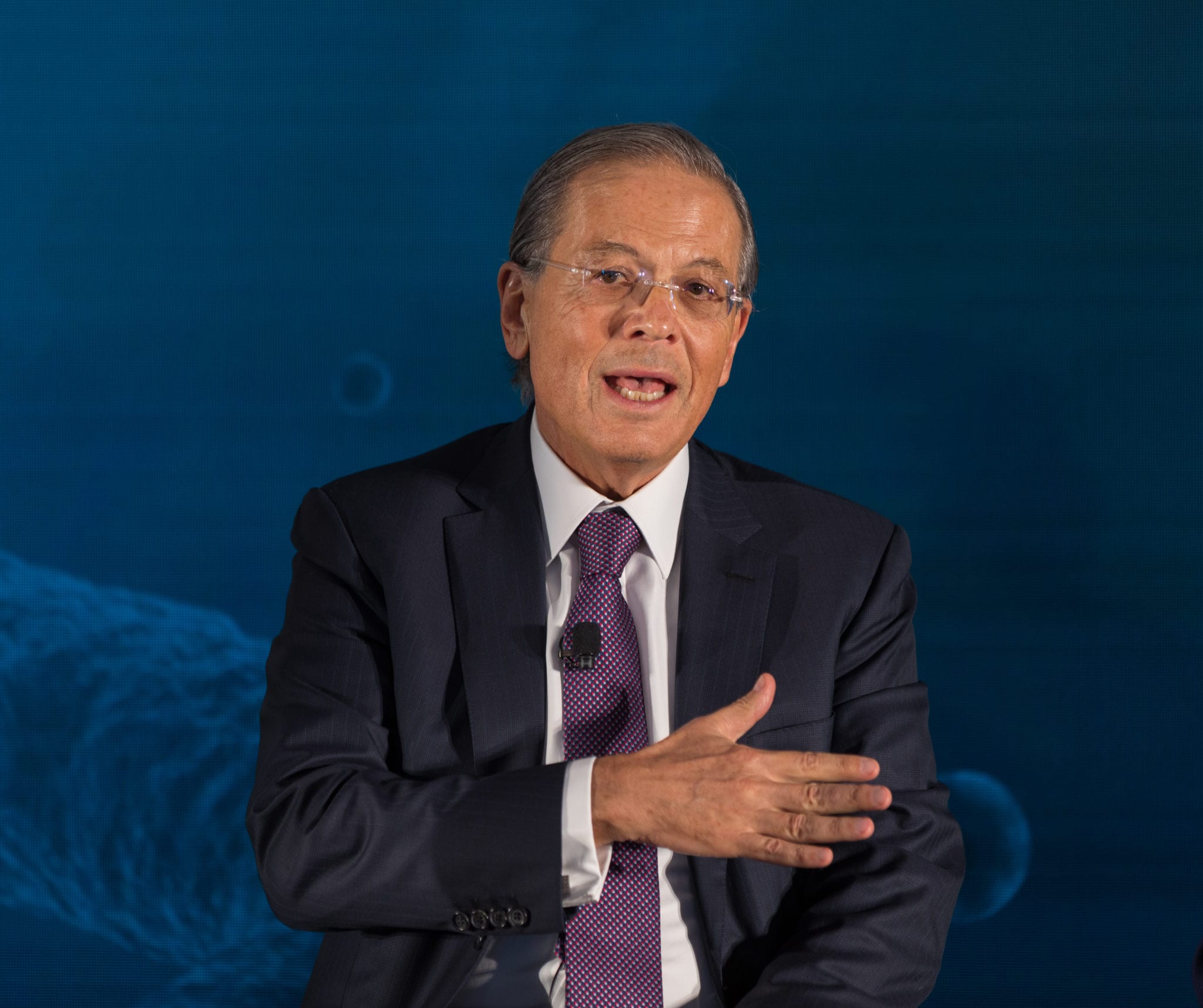 Arie Belldegrun
Arie BelldegrunOur understanding of the immune system was incomplete. The importance of T cells in mediating an anti-tumor activity was not clear, let alone the ability to molecularly engineer T cells to become super-killers. For example, we believed that the ultimate goal to achieve a better anti-cancer response was the ability to generate a large number of activated T cells, by keeping them longer in culture.” The more the merrier” approach. Then came the important work in the laboratory, led by Dr Restifo, that in order to empower cells to better kill targets one should aim to limit the time of these cells in culture, and rather generate younger and less differentiated T cells . Such principles, based on solid data, changed the entire thinking process of our industry, and led to search for the optimal in vitro Growth conditions of activated and engineered immune cells.
We have made significant scientific progress in the past decade. Based on what we know now immunotherapy, cell therapy and targeted agents are the new frontiers. The next decade, will all be about rational combination therapy. The true challenge will be developing powerful tools to fight solid tumors. In regard to cellular therapy, the next frontier will be solid tumors. One should always remember that 90% of the patients dying from cancer are those with solid cancers. This is the big box we need to address. It will require to combine cellular therapy and targeted therapy based on personalized molecular signature of a specific tumor. It will also require combining immunotherapy with other emerging cancer modalities, such as theranostic, oncolytic viruses, and cancer vaccines.
I don’t think we have even started to scratch the surface of cell therapy. Why do we need to go with poison when you have your own cells, who know their way in the body and can best home to fight foreign invaders. All we need to do is empower them with the right tools. The two recently approved CAR T products are a proof that engineered T cells can effectively fight cancer and generate long lasting remissions and even cures. And so far we have only addressed their role in oncology, which is the lowest hanging fruit. Autoimmune diseases, IBDs, and even AIDS are other opportunities to explore.
Wendell Lim: I agree with Arie that we’ve just scratched the surface of cell therapy and cell engineering. I think that the technology we have now, the CD19 CAR is amazing. But we’re sort of lucky, right? Because CD19 kills normal B cells, but that’s an expandable compartment. It’s not perfect in its recognition. I think we have a long way to go in terms of solving the problems for solid cancers. But I think that there’s incredible promise, because the way we look at it as living cells, especially cells of the immune system, are in a sense the most sophisticated sort of computational and robotic devices. They are a type of nanodevices If living cells weren’t very precise in what they do, we wouldn’t be alive today. So they are very sophisticated machines. And if we can really understand more globally and foundationally how to engineer them and engineer how they interact with, say a tumor tissue, and have a conversation with it and interrogate it, I think we can have much more sophisticated therapies.
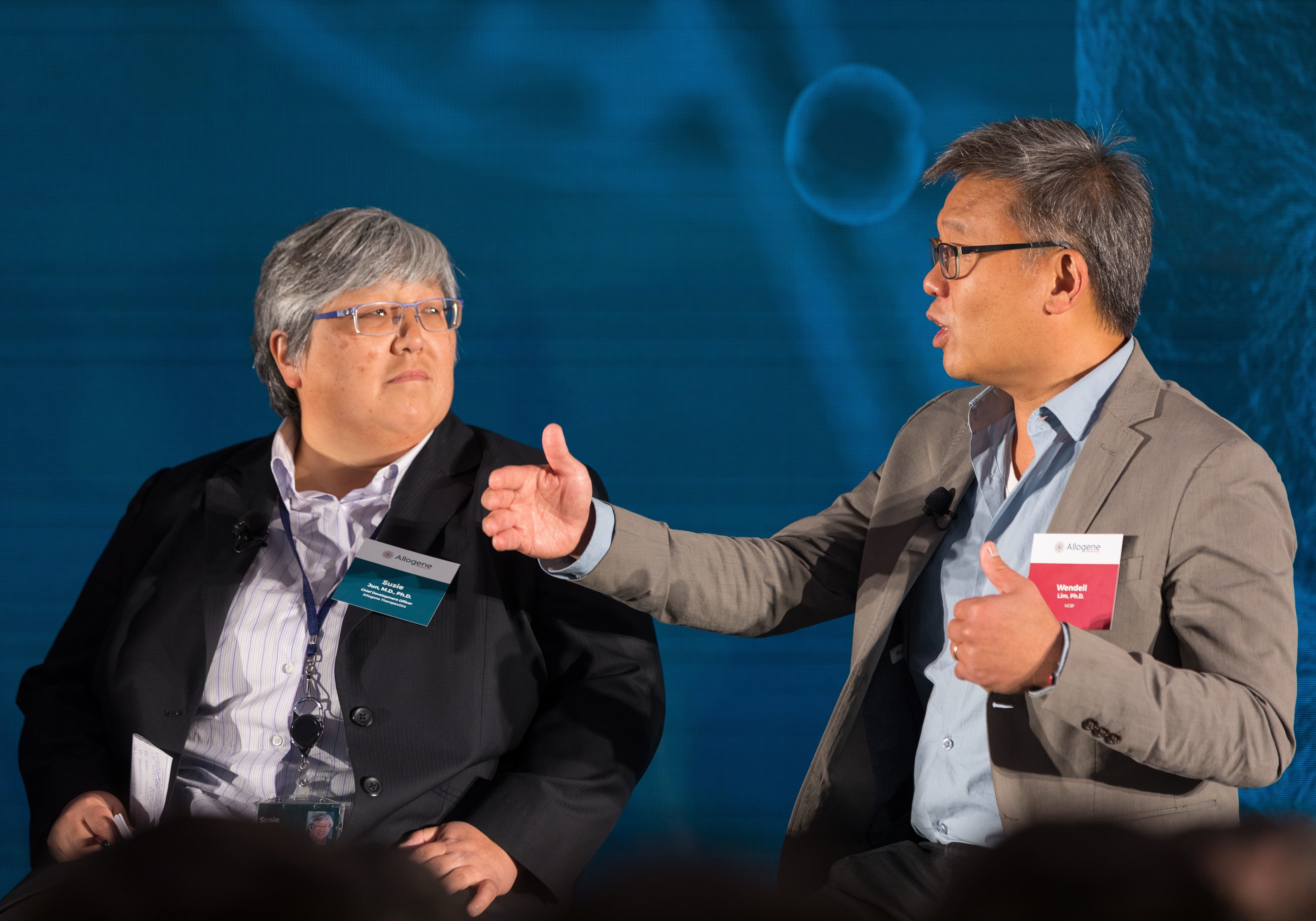 Susie Jun, Wendell Lim.
Susie Jun, Wendell Lim.I view the cell as a platform for combination therapy because you could have a cell that both recognizes a tumor and kills, but also produces things that will disrupt the tumor microenvironment, and the ecosystem that stabilizes the tumor. I think we can start looking at this problem in a much more nuanced way, and potentially open up an industry that is more like the electronics industry or programming, where the tools are there to do many different things. And then we can take genomic data about disease, use machine learning to figure out what are the opportunities that we can recognize, the vulnerabilities that we can take advantage of, and have an industry where it’s more about their creativity than having to struggle to develop new technologies.
John Carroll: Well it’s interesting because the tools also seem to be a work in progress as well, right? Gene editing itself has got to be able to establish itself and prove itself. And then not only what’s the best way, but what’s gene-editing 2.0, and then on and on and on from there. So, the complexities are actually quite extraordinary. In looking forward, how do you make projections in terms of what you’re going to be using and how do you pick them up along the way, just in the right sequence?
Wendell Lim: I think we have different timescales at which we have to operate, being that we need lots of different stakeholders, whether it’s startups that are really trying to push things quickly into the clinic, or academic federally funded research that has maybe a longer timeline. Because I think there are different kinds of problems we have to solve. I think maybe this is a good question for the analysts. If cell engineering goes towards say programming or electronics, it means that we may have the capability of, every year, coming up with a version 3.1 and so on. And that’s not necessarily in the best interest of every individual company, right?
So there will be some pain. If we succeed, then there will be some transformation in exactly how the economics of this work.
John Carroll: Great successes and great failures. So how does the market analyze this and take this into account?
Michael Yee: Well, I thought you brought up a couple of good points. One is, if you think about back in 2009, you’re absolutely right. We couldn’t do an IPO. Nobody wanted to touch biotech, healthcare.
John Carroll: Too much risk.
Michael Yee: Thought the healthcare system was going to be turned upside down with Obamacare. It was pretty bad. I’m sure you remember those times. And now it’s 2019. You’ve got 45 IPOs this year, $30 billion in follow-ons. $15 billion in IPOs. You can come up with a new company and get funded right away. Now part of why I’m excited and I think most of us in the audience are excited, are two things. One is, I think we can all agree that the breakthroughs in
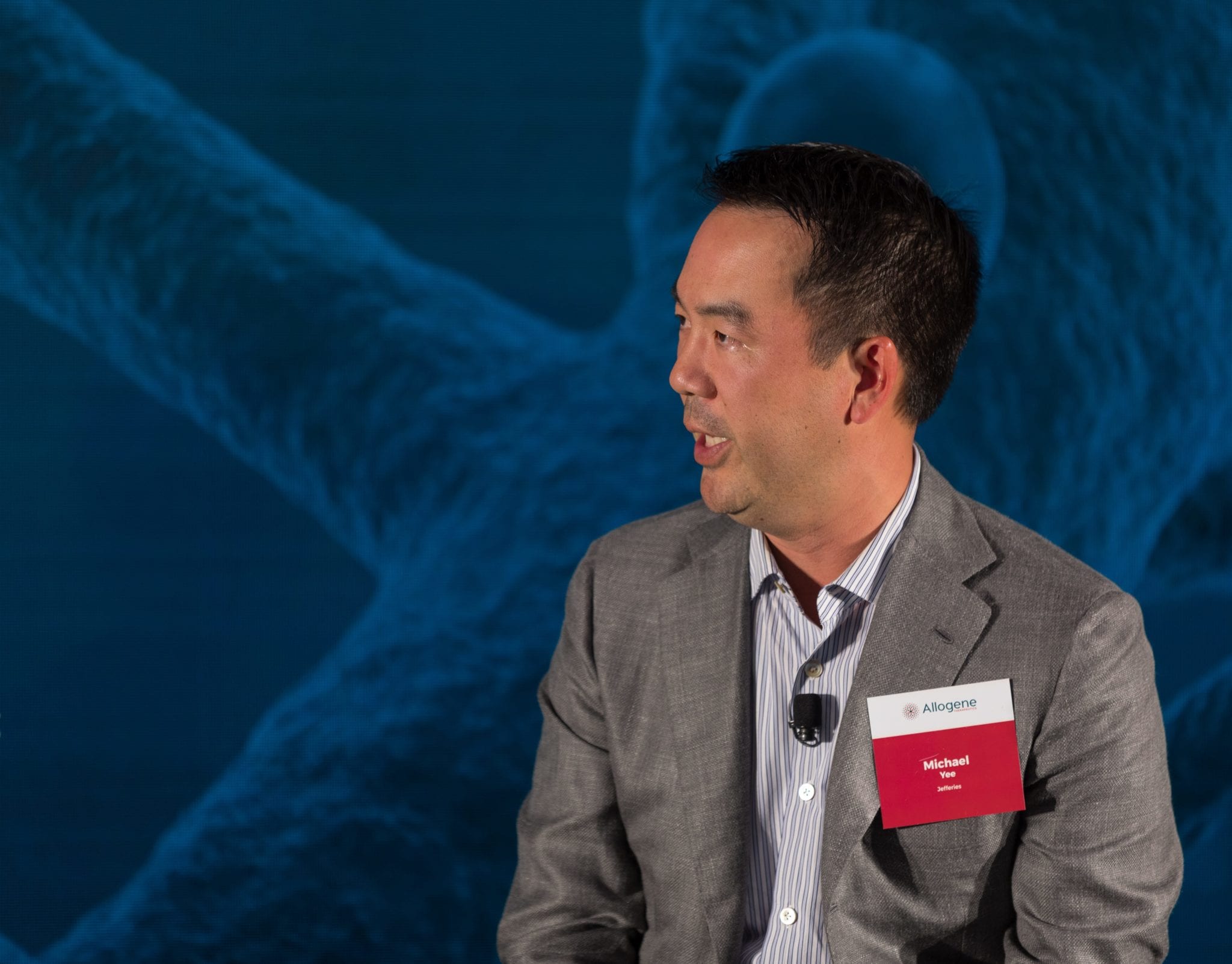 Michael Yee
Michael Yeescience, gene therapy, gene editing, cell therapy, IPSC cells, and what is going to come about in the next few years. Obviously, we have some gene therapy drugs approved. We have cell therapy drugs approved. And we’re going to get 2.0 and 3.0. And there’s a ton of money funding all of that to get us going. I’m pretty excited about that.
The second thing I think is exciting, is that with all of this money and with all of these competing technologies, there is going to be a constant evolution. And it’s a bit scary because on the good news that’s great for the patients. That’s great for innovation. The most challenging part about that, which is probably something Ziad thinks about, and so many investors think about is, well wait a second. I’ve got CRISPR CAS9, I’ve invested in this company. Wait a second. There’s a single base pair gene-editing company right behind it. Well, I’m thinking about allogeneic cell therapy. Wait a second, there’s IPSC coming around the corner. So, the challenging thing and exciting thing about it is, there’s going to be a ton of innovation, and it’s going to be hyper-competitive, but that’s great for patients. And maybe that’s a debate that Ziad has to think about.
John Carroll: Take it away.
Ziad Bakri: Yeah, I would echo all of those comments. I would say that a lot of the innovations that you see are the result of new tools that have been developed. It usually takes a few years. But down the line those new tools have new applications. And Arie was saying it was surgery, chemo and radiotherapy. And after that, we had kind of small molecules and biologics. And now we have cell therapy, gene therapy, gene editing. There’s IPOs all the time for companies in RNAi, and delivering RNA, in fact, cancer vaccines. So, I do think the world is going to go in 2030 towards a world of combinations. If I think about some of the big innovations in cancer, Franz Humer’s previous company Roche, what did we do with NHL, right? We started off with CHOP chemotherapy, which itself is a combination of four chemotherapies.
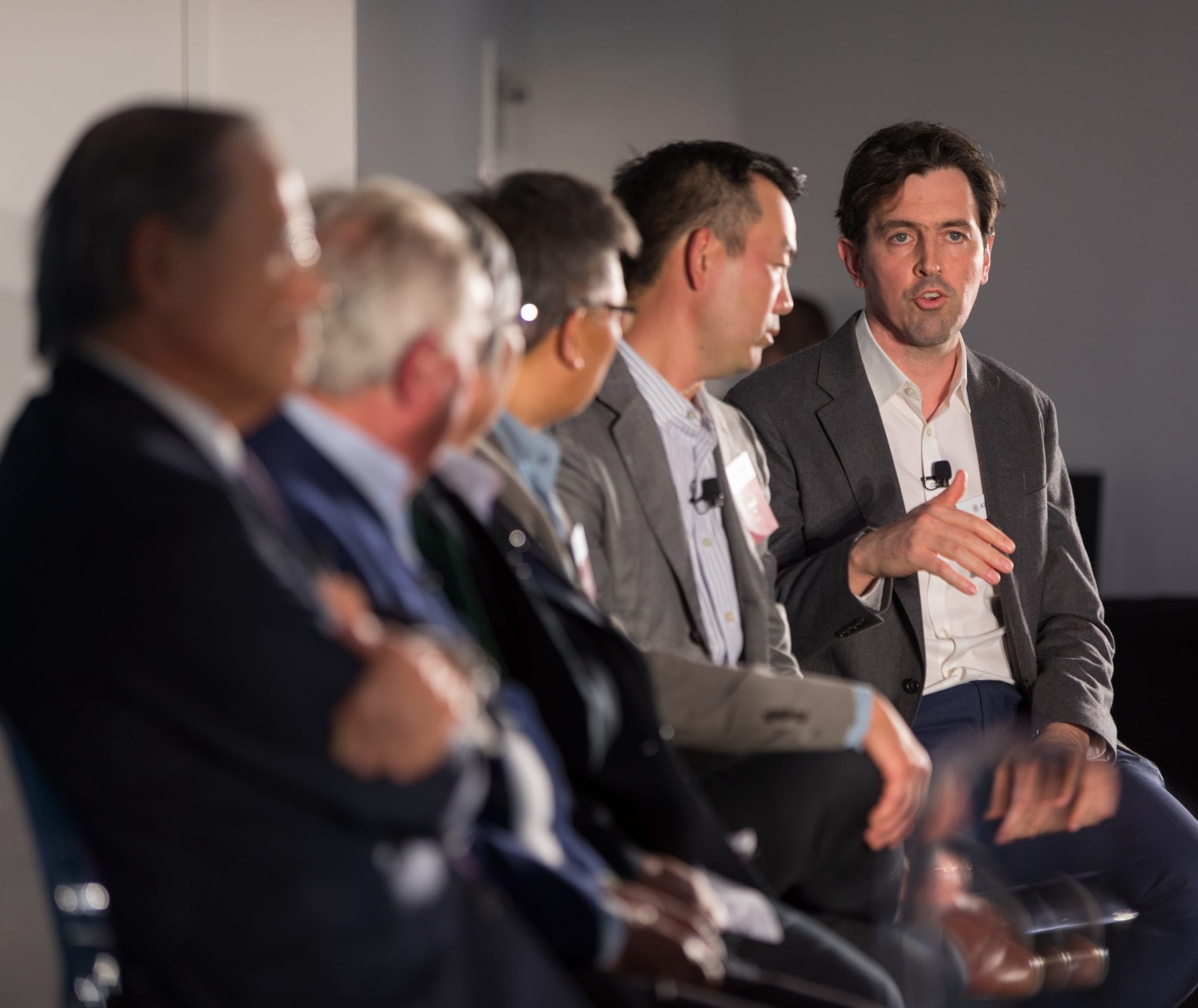 Arie Belldegrun, Franz Humer, Susie Jun, Wendell Lim, Michael Yee, Ziad Bakri
Arie Belldegrun, Franz Humer, Susie Jun, Wendell Lim, Michael Yee, Ziad BakriAnd the big innovation there was the add Rituxan onto that to further boost the cure rate. The same thing was done with HER2 breast cancer, right? With adding things on to boost the cure rate.
With the improved depth and speed of sequencing and analyzing populations, and basically redefining subpopulations of disease, and being able to say, hey, breast cancer is actually kind of hundreds of different diseases, we’re able to come up with more targeted approaches. And for those, we need the tools. There are many more tools in that world. There will continue to be more tools. And partnering between companies is going to be very important. You see a lot of the big pharma companies do that, and you saw for example with Kite. Kite had multiple partnerships. So, I think in general one company is not going to have all of the tools, but I think partnerships are going to enable that. And that’s ultimately going to lead to effective combination therapies.
John Carroll: So Susie, there’s been some discussion on the combination therapies to come. The complexity of the field in terms of putting these different things together and moving them from a preclinical out into the Phase I area. So, when you look at the kind of complexity, making these choices is going to be critical to long term success. So how do you go about doing that? What is the process? What are the considerations that you use for that? And how do you take that into the clinic?
Susie Jun: Yes, I’ve been listening to the comments, and to Arie’s point, if we think back and try to see how that would apply to the future. I do think the conversation will start changing. As our understanding of translating the technology, translating some of the informatics, just trying to understand the complexities, we become more sophisticated in the way we characterize products. We will focus more on transformational differences as opposed to incremental differences. We’ll also translate that into speed. We talk about the cost of drug development and how long it took. Eight years, I know you guys were proud of that [at Kite]. But I think as we become better at applying our understanding of cancer immunotherapy as well as the technology, that speed will increase. It will get faster.
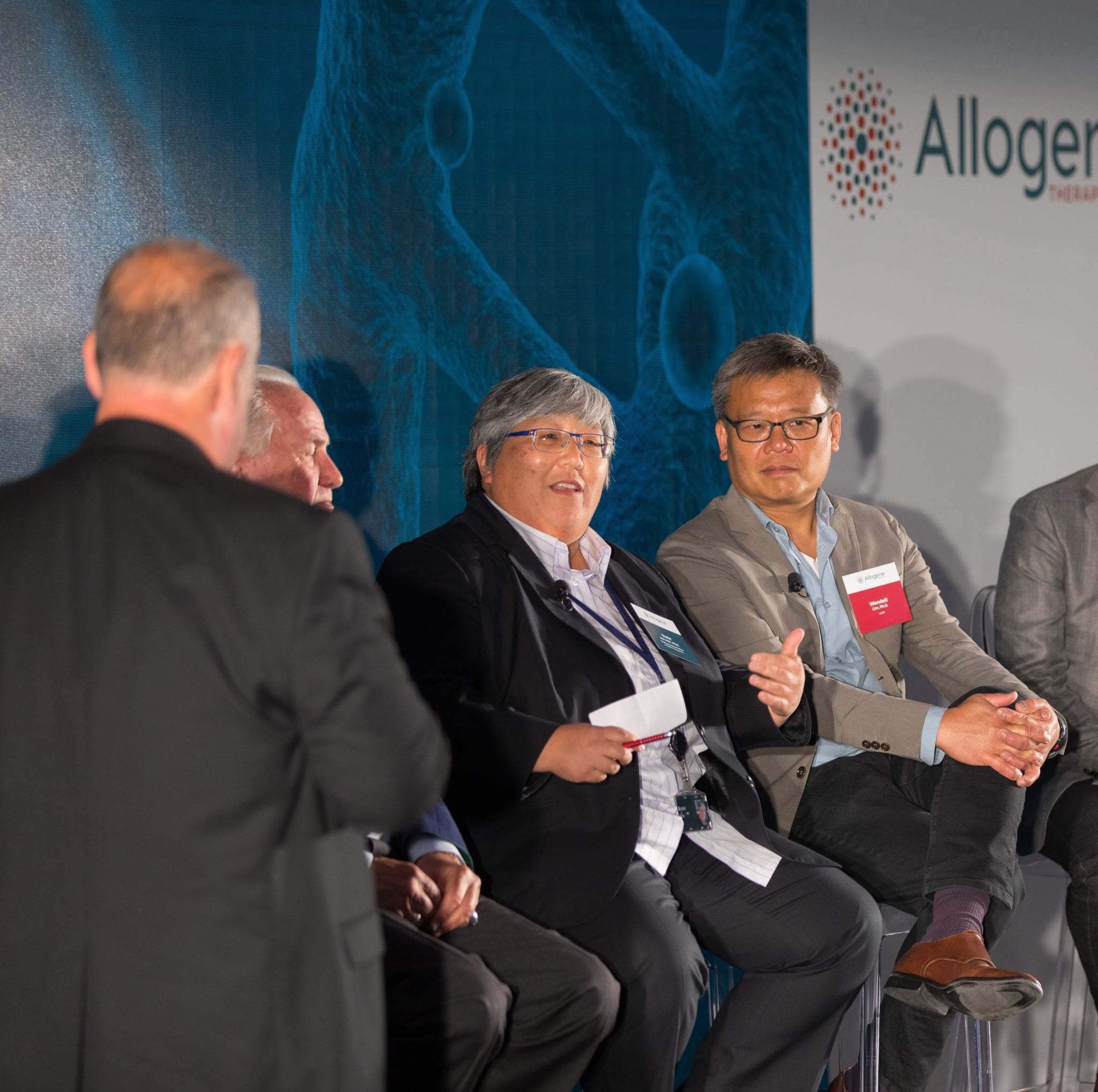 John Carroll, Franz Humer, Susie Jun, Wendell Lim
John Carroll, Franz Humer, Susie Jun, Wendell LimAs it gets faster, we’ll become much more efficient, so we’re not going to be looking at one in 10 drugs getting approved or having failures in Phase III. I think we’ll be better at picking drugs earlier. And being more efficient in our drug development. It will go faster. It will cost less. These translations of some of the technology and some of the emerging biology will also lead us to conversations more about picking the right drug or the right combinations for each patient. So we won’t be talking about 20% or a 40% or even 50% complete response rates. We’ll be talking more about which drugs will always work for every patient. And we won’t be talking about proportions of response. We’ll be talking about which combinations will lead to a response early, and then trying to apply some of our understanding of technology to figure that out, so we don’t have to wait three months before we know that.
John Carroll: It would be a revolution if a larger company were able to increase their success rate of Phase I through Phase III, from 10% to 20%.
Susie Jun: Exactly.
John Carroll: It’s one of Hal Barron’s favorite comments right now. After he took over the R&D group at GlaxoSmithKline. If I can have a 20% success rate, and only 80% failure rate, then I’ll be a genius.
Susie Jun: Exactly.
John Carroll: And I think that a lot of people are thinking about that in terms of how they position their own company, and how they go about it. I am curious about the big pharma perspective because Roche had an opportunity to mess everything up when they took over Genentech. And this was a lot about innovation and in terms of whether or not you can do that and do it successfully. You’re now looking at drugs like Hemlibra, Ocrevus, Tecentriq, drugs like that, that are making an enormous difference. And have legs, it’s like franchises. They’re just incredible. So I am curious when you look at this kind of fast-paced change, traditionally big pharma doesn’t do well with fast-paced change. Do you think that this can be altered? Because they intend to.
Franz Humer: Not every big pharma company behaves the same way. American companies, American big pharma, with very few exceptions have the tendency to centralize everything and to try and control everything around the world.
 Franz Humer
Franz HumerI think my personal feeling is and conviction is, if you want to be successful in R&D, you’ve got to decentralize. And that was really the guiding principle behind how to manage Genentech. To give you a stupid example. I said nobody is allowed to travel to South San Francisco without my approval, because everybody wanted to go to South San Francisco because first of all, it’s great. I travel to California, which means I’m out of the office for a week. Wonderful. I like the climate in San Francisco. I like the food. And then I have great conversations with the people there. And I come from headquarters, and I can tell you what to do. Which is exactly the wrong way to operate, not only by the way in the US, but also in Japan.
So, the success of Genentech was really built on maintaining its independence and having 100% confidence in the research group. Art Levinson and his team. I sat on the board for 10 years, and I took the negativism from my colleagues in Basel once a week. And once a month. And at every budget discussion. We could save hundreds of millions if we would just not allow Genentech to do X, Y or Z. And I said, Art, you do what you want. And Art spent 87% of his sales in R&D. And I said, I have confidence in the guy. I think he and his team will make it.
Turn around, go 10 years forward. We bought 60% of Chugai. As Japanese a company as can be culturally. Hardly anyone spoke English. I liked the head of R&D. He was a great guy. And I said, we are not integrating Chugai research. We leave it as is. Today, the Chugai research center outside of Tokyo is as productive as Genentech. And it has something to do with the way you create and sustain a culture in an organization. You create what David [Chang] and Arie are doing now at Allogene, the pride in achievement of a group of people who can look into each other’s eyes and say, yes we did it. And yes, we will be rewarded for it. Being rewarded is not the first thing.
Sorry. I need to be careful because otherwise you will quote me. What are the things that you could
As soon as you say, I need to reward my researchers in San Francisco or in Los Angeles the same way as I reward them in Basel, it doesn’t work, because the culture in Germany, Switzerland, Austria, the UK, the US. Even in the US, it is different than it is on the East coast or on the West coast. And if you think you need to unify, you destroy in the process of unification. That’s why I believe the success that will be in the future, very successful large pharma companies, they will operate like a network around the world, in terms of research, and in terms of development until the end of phase two or proof of concept. When it comes to running globally, especially in the non-oncology areas, global phase three, phase four programs, nobody does that better than large pharma. Commercialization, large pharma isn’t too bad either.
John Carroll: So in terms of large pharma, of course, obviously the initial group, your pioneer group here at the company came from Pfizer. And you put that together. And Pfizer, to their credit, understood that this was going to go faster in a different sort of a situation, it seems to me. So that’s a different kind of a model in terms of how Pfizer, how a large pharma company can operate. Do you think that culturally, those smaller companies are more nimble, faster? Are they better by nature?
Arie Belldegrun: Yes, small companies are more efficient than the large pharma, but they are learning from their own mistakes and changing. See the case of Pfizer. While working with the upper management of Pfizer, specifically with John DeYoung and his team at the oncology business development, David and I saw a major change and reversal of their original intent for allogeneic CAR-Ts. Pfizer realized that forming a focused, nimble, and dedicated company, comprising of experts in the field – will be more productive and beneficial to all.
 Arie Belldegrun
Arie BelldegrunSo sometimes even the largest company in the world can positively change and generate a win-win situation that benefits patients, shareholders, and the internal employees at the company that were very passionate about bringing an allogeneic product to market.
Our negotiation with Pfizer was very constructive and generated significant enthusiasm on both sides. We early on realized that Pfizer intends to become a partner in our efforts of bringing allogeneic drugs to the market, rather than just a seller of existing internal technology. They were committed to see us building a focused and dedicated company, using their core employees as the seed for the new company. As negotiation advanced we were encouraged by Pfizer requesting two board seats in the company, and agreeing to invest and buy into the company. I believe that the management of Pfizer is currently pleased with the outcome of those months of negotiations. Of note is that they have recently expanded that model to at least one or two other areas of spinout ., I believe that this is a forward-thinking model of how PHARMA can work with other experts in the field for the benefit of both sides. The fact that we have an open communication line to Pfizer and know that our interests in cell therapy are aligned is very encouraging and helpful. The team at Allogene is very pleased with the outcome and with all the support it has received from Pfizer.
Franz Humer: You know, if I may…
John Carroll: No, absolutely.
Franz Humer: Add to this a little bit. You just need to sit in a board meeting of a large pharma company and in the board meeting of Allogene. In Allogene, we have detailed presentations about manufacturing, detailed presentations about each development program of each drug. Each research project is being discussed and presented. In large pharma, you spend your time on the remuneration committee, the audit committee, the risk committee, the governance committee, the nomination committee and whatever else there is, as a committee. But you don’t have time to think. To think and discuss what is at the heart of this business and that is innovation
John Carroll: I was talking to Norbert Bischofberger when he left Gilead and went over to be a part of the start-up Kronos Bio, and he said he was tired of having a job that was mostly about HR, and just about hiring and the whole area of staffing and how to go about doing that. So I am kind of curious, I mean from a Wall Street perspective, how you go about trying to determine who’s good. And I got to tell you the first time I saw this guy in action, was a few years ago in New York.
Arie Belldegrun: You were not nice to us.
John Carroll: I was…
 John Carroll, Arie Belldegrun
John Carroll, Arie BelldegrunArie Belldegrun: You were not nice to us.
John Carroll: No, what’s funny is, that was my nice side.
Arie Belldegrun: Ah!
John Carroll: So.
Arie Belldegrun: David [Chang] remembers that.
John Carroll: Yes, the first time was —
Arie Belldegrun: I won’t even look.
John Carroll: The first time, was at an R&D day that you guys did in Manhattan, and everybody was just like you said it was — this is manufacturing, this is R&D, this is how we break it down. And everybody knew exactly where they were, and this is part of the whole revolutionary approach to biotech. Where you start a company and you don’t say, well, we’ll get to manufacturing later on. You start thinking about manufacturing, which is absolutely critical to every new area that you go into. It’s going to be critical in gene therapy, critical in cell therapy, critical in stem cells. It’s going to be so important. And those companies that are doing it right early on have the lead and have an advantage over everybody else.
John Carroll, Arie Belldegrun, Franz Humer, Susie Jun, Wendell Lim, Michael Yee, Ziad Bakri
Click on the image to see the full-sized version
John Carroll: So, when you look at these companies from a Wall Street perspective, is it a more of a holistic approach?
Michael Yee: I think that there are two components that we pay particular attention to. One is the people, right so you have 10 different cell therapy companies, you have 10 different gene therapy companies or more. It’s certainly more than 10, and I think that a lot of these investments early on, particularly when there’s no data, not a lot to go on, it comes back to the people. Whether that’s Arie and team, or whether that’s others that have done it, been there and know that it’s about A to Z, not just you know, the early parts. That’s one huge component of it and I’m sure you would agree that management is a key component, particularly when it’s a small company.
The second part is resources and obviously they’re a bit interrelated, but those who have the most resources, those — I’m talking about capital — and those who have done it, those are the teams that typically people are going to be placing their bets on.
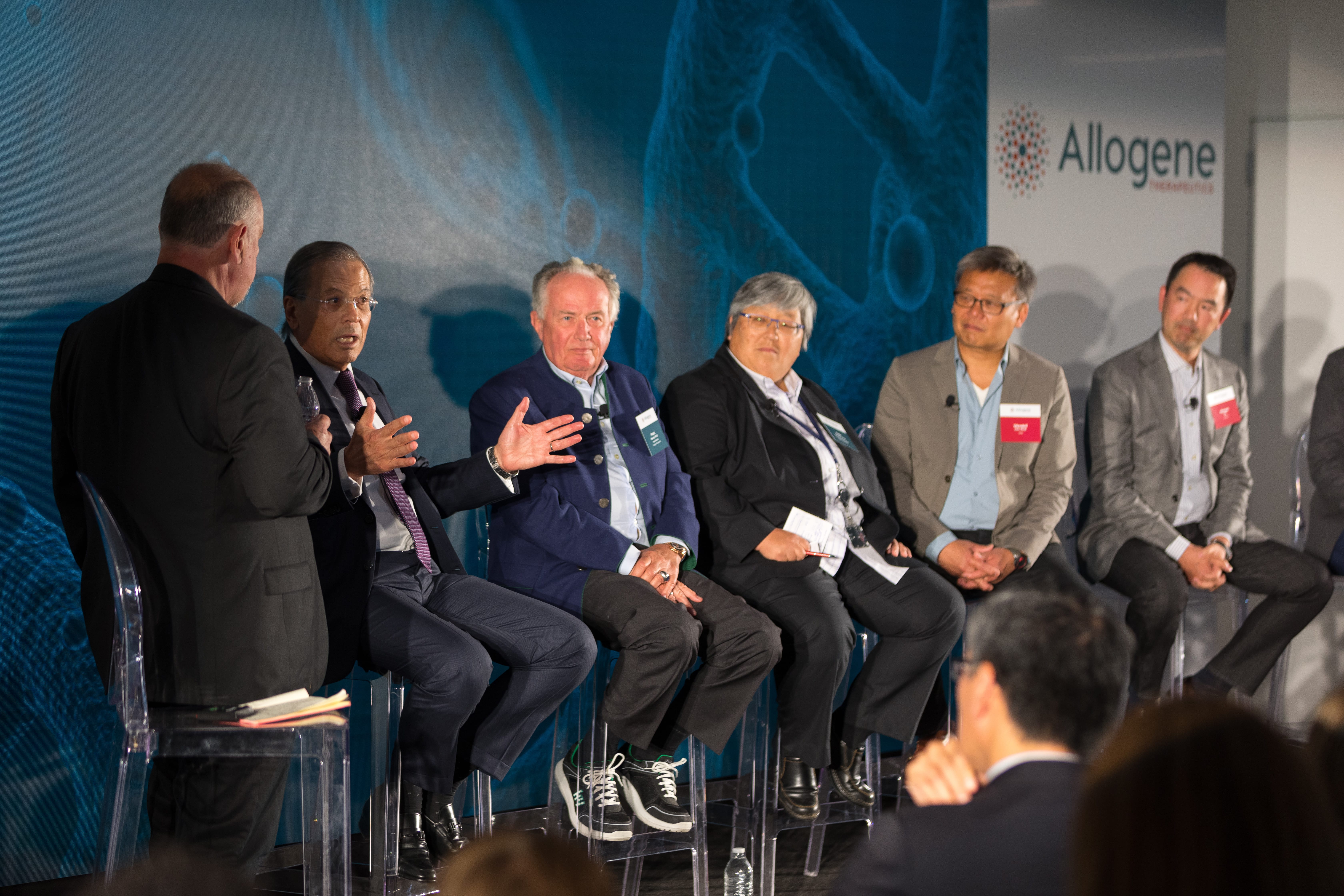 John Carroll, Arie Belldegrun, Franz Humer, Susie Jun, Wendell Lim, Michael Yee
John Carroll, Arie Belldegrun, Franz Humer, Susie Jun, Wendell Lim, Michael YeeArie Belldegrun: On the resources issue… I would like to bring up the great importance that the board of directors in a small company with limited resources, like Kite or Allogene, plays in the overall progress of the company.
At Kite, one of the most difficult decisions the board had to make was a 2014 decision of building our own manufacturing plant. After listening to the recommendations made by management the board agreed to allocate funding, from the IPO proceeds, to build a first of its kind manufacturing plant, at a time the company was still in very early clinical development. The board trusted its head of R&D, David Chang, in saying that the clinical data is encouraging, and in order to stay ahead of the competition we should build our own plant. That bold decision, and the pace it all happened played an important role in the overall success of Kite. I believe that such a decision in a big PHARMA would have taken much longer, with many more committees involved, many more questions asked about the proper timing for such a buildup and a completely unknown outcome. That why a savvy and experienced board in smallbiotech companies can make a great difference in the outcome.
John Carroll: I’ve spent a lot of time trying to follow what people are interested in and it used to be money. It used to be that $100 million was like a magic figure. It got a lot of attention. What gets attention right now is people. Every time you get right down to it, it’s like when you go into someplace like Chugai and you say, “I like the R&D director, I’m going to trust the R&D director, that this person’s going to do the right thing and be successful the way I think that they are.” And to me, that’s just incredibly important. You’ve got to understand who the people are and who is going to be able to perform and who was not going to be able to perform.
If you were a younger person getting into this industry at this point, which I think is a critical point because only 10 years from now you’re going to see a whole revolution in terms of who’s running these companies, and they’re going to be a much younger set. So, if you are coming into any kind of a company in this situation as a staffer, how would you approach things then? And what are people looking for? And, and what is the best way for somebody just getting in the industry for the first time?
Susie Jun: Well, I appreciate the comment that I’m on the younger generation.
John Carroll: You got me beat.
Susie Jun: I think the things are similar to what we’re talking about is what you guys are looking for, right? I mean, I think young people, and I’m going to speak for the Allogene workers and you guys can argue with me, but they really are looking for leaders who have vision and who have commitment. And you know, certainly working in big pharma, there are lots of leaders who may have vision, but you never really feel like they’re super committed because they’re so dispersed and they do a lot of different things. And I think when you’re looking at a small company, you understand
there’s a lot of risk. You could be out of a job in a year and you’re young. So you might have family, you might have a house, you might have a car or a pet. But, you really want someone who’s going to show you that they have a vision. So it needs to be a big vision, it’s not a small vision and that they’re committed. They’re going to put in the effort, do what it takes and really think carefully before they commit your time and your life to their vision.
And, I think that’s what young people are looking for. I’m going to look around the room, you guys can argue. No one seems to be raising their hand. Okay, good.
John Carroll: I mean, what about from your own perspective? What are your thoughts as it relates to the generational change that we’re experiencing?
Wendell Lim: The kinds of technologies that we’re talking about, gene editing and so forth, it’s much like with digital natives — the younger generation are much more comfortable with those sorts of ideas and can think without some of the cultural baggage about that. Kids in high school and middle school are learning about these sorts of things. I think they’re going to be in many ways better prepared to lead the next wave of innovation. But I think as you guys have all said, this is a hard business and you need experienced and dedicated people, people who build a culture that can work and there’s not just one solution, but they do have this common thread of dedication and real thought going into what decisions are made.
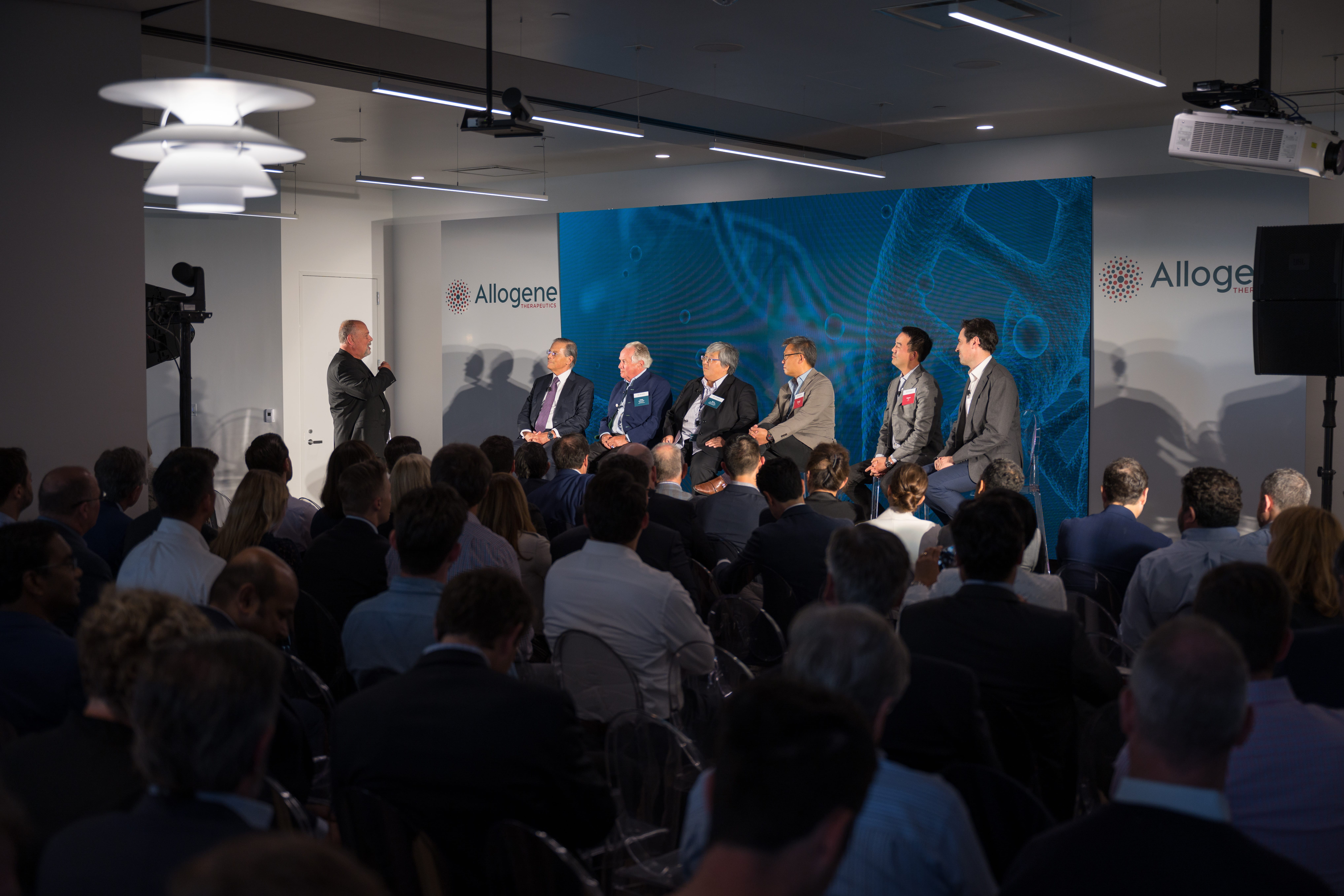
John Carroll: So the first part of this conversation was about science and technology and the things that are important in terms of growing a company and pointing yourself towards 2030. Which is all pretty positive, right? The news flow in the industry has gone from this to here over the past 10 years. It’s just really extraordinary. I’m sure you guys have all seen that from your own various perspectives. Things are much more active. On the other side of that, never has the pharma industry had a worse reputation than it does right now.
Gallup just did this poll where they saw the pharma industry is actually lower than the federal government, in terms of people’s negative feelings It was absolutely rock bottom. You’re going into an election year in which every candidate who’s got a shot at this thing is taking a shot at pharma. They’re taking a shot at the industry. They’re taking a shot at drug prices, which has got everybody going. You have an opioid crisis which is being applied to everybody in the field — like everybody’s involved, ripping people off, doing whatever they can, and it’s an incredibly negative environment. As far as the public is concerned. From Wall Street’s perspective, it would seem like things have to change.
Are we headed for a real kind of a real crossroads as it relates to pricing and the public environment for the industry?
Michael Yee: So, I think I’m the most hated guy here because I work on Wall Street, so everybody hated Wall Street people in 2009 after the financial crisis and our work in biotech, which is like a pharma, which is the most hated group ever. So, I get to get that award, but I’m a little more optimistic and I would say that those of us who have seen the cycle and go back to 2008 and 9 when it was pretty tough when we thought that there was going to be a revolution of socialized medicine or at least the early parts of it with Obamacare and I do think that we’re, reliving in that cycle too, in a greater degree now, where we are the targets, again.
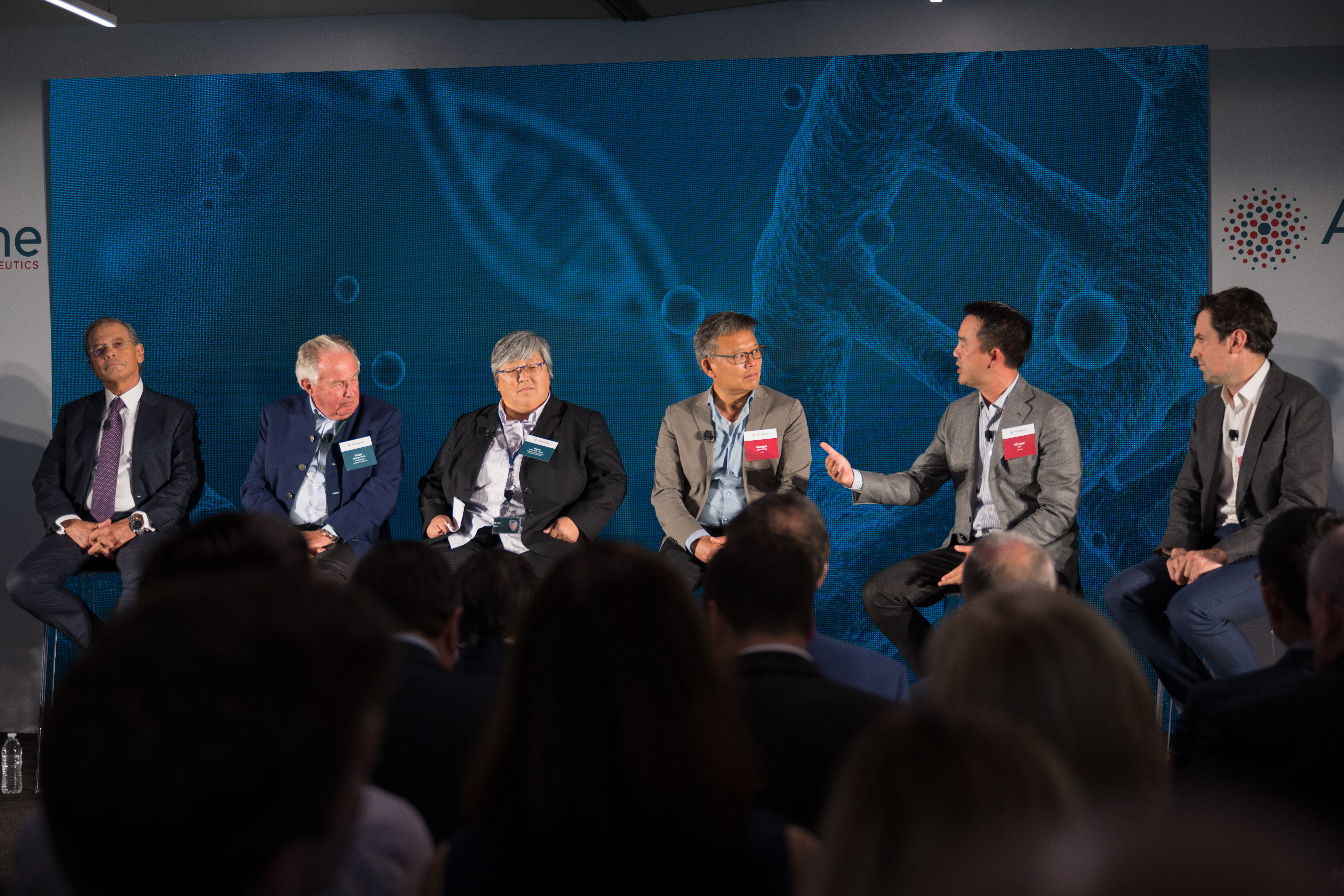 Arie Belldegrun, Franz Humer, Susie Jun, Wendell Lim, Michael Yi, Ziad Bakri
Arie Belldegrun, Franz Humer, Susie Jun, Wendell Lim, Michael Yi, Ziad BakriI’m more optimistic because number one I do believe that, and I’m sure most of us believe here that a lot of it is rhetoric, a lot of it is political. Whatever hot topic is today, whatever can get votes. I think that is whatever they want to talk about, and I’m optimistic that some of this will pass. So that’s part one. Part two, is I’m optimistic because I think that those of us sitting here know about the types of transformative, innovative medicines that make a true difference, not incremental difference. Gene therapy, cell therapy, et cetera, and therefore, that there is clearly a pharmaco-economic formula to pay for things that save your life and are not incremental. So, while I think that the system on how to pay for that, whether that’s rebating, paying for our performance, whatever that model is, I think will evolve.
I’m optimistic that if you are coming up with drugs and make a difference, there will be a system that pays for that, particularly in the United States.
John Carroll: Do you see this as evolutionary or revolutionary?
Michael Yee: I see it as evolutionary, and I believe that there probably will be some form of a legislation passed to say that they got something done, but I don’t think that it’s going to change the system. And for those coming up with transformative drugs, there will be a system to be paid for that.
Ziad Bakri: I agree. I think it’s evolutionary. I think if you followed a lot of these cycles, election cycles, this is always a hot topic. It is definitely more of a topic now. And a big part of that is that maybe starting about eight to 10 years ago there just became this very kind of liberal price increase environment. Right? The problem has been that a lot of these drugs have been around a long time and maybe they’re near the end of their patent life. The effect of compounding prices seven, eight, nine percent a year, by the time you get to 10, 12, 14 years out, it is pretty dramatic. And the one thing is that the really innovative drugs and the new breakthroughs, maybe with the exception of the hepatitis C drugs, that’s the only exception I can think of, have all commanded very good prices.
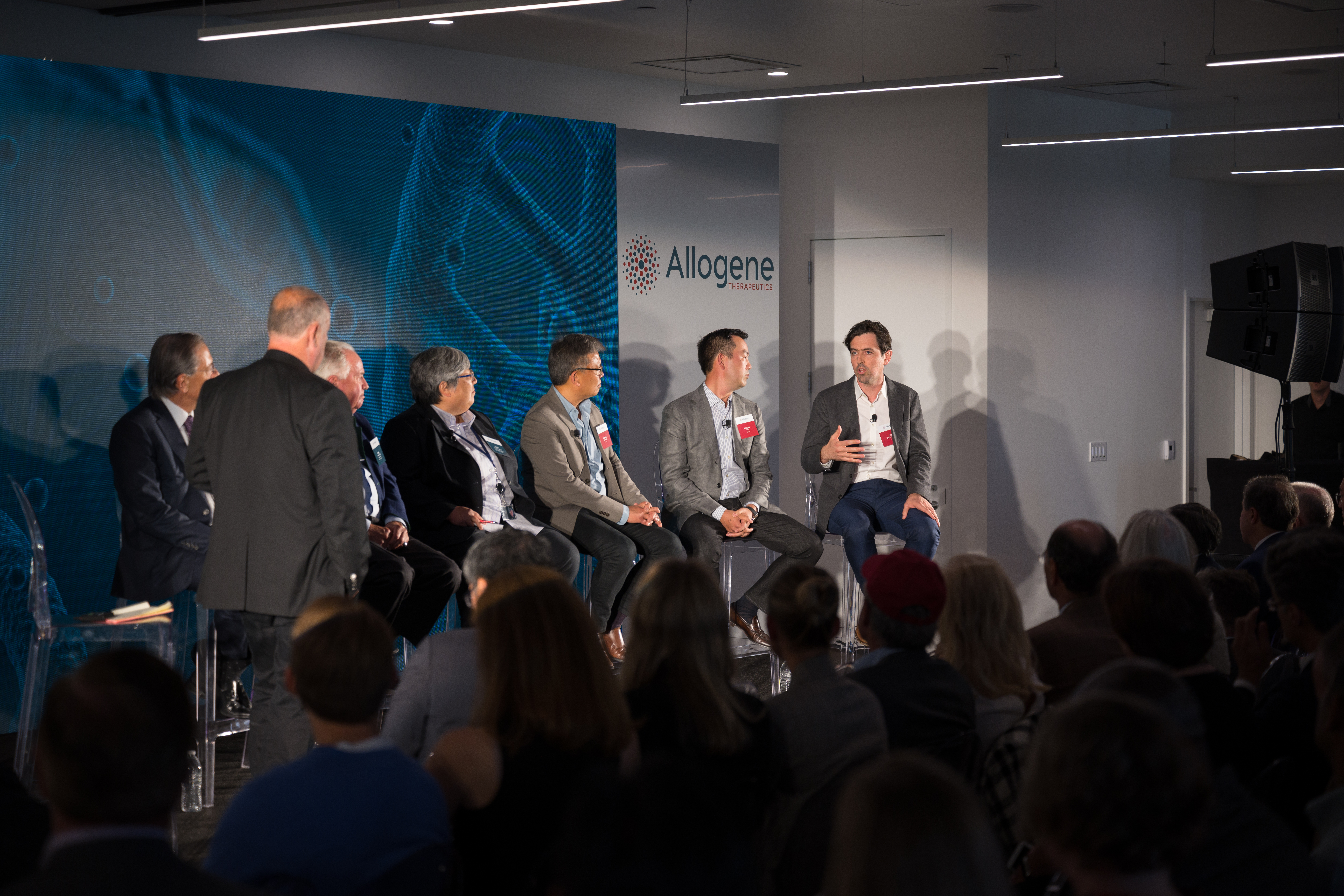 Arie Belldegrun, John Carroll, Franz Humer, Susie Jun, Wendell Lim, Michael Yee, Ziad Bakri
Arie Belldegrun, John Carroll, Franz Humer, Susie Jun, Wendell Lim, Michael Yee, Ziad BakriThe system’s kind of been willing to reward real innovations, especially when it’s the only innovation of its kind when it’s the only drug in this class, when it serves a big unmet need when the disease is severe or fatal and there were no other options for patients. So, that’s kind of always been the case. What happens to the incremental drugs and whether their prices are reduced or controlled. I don’t know. In the areas that we’re talking about, where Allogene and similar companies are operating in, you know there’s always going to be good rewards in the system.
John Carroll: How do you adjust for the future as it relates to where we are now in this discussion?
Arie Belldegrun: I personally don’t adjust for pricing. I think of innovation, scientific progress, and bringing disruptive products to patients.
John Carroll: I always love talking to executives about pricing.
Arie Belldegrun: I can clearly see that some things never change. Discussions about drug pricing around election time is one of them. What I am more concerned about these days is losing our competitive edge to China. At this time the biggest scientific innovations in the world are happening in life sciences and in the United States. Having closely followed the progress of science and biotech in China in the past 5 years I worry that the gaps are rapidly closing and as a consequence, we may lose the competition. Cutting R&D in order to justify cost-cutting and lower drug pricing is the wrong solution.
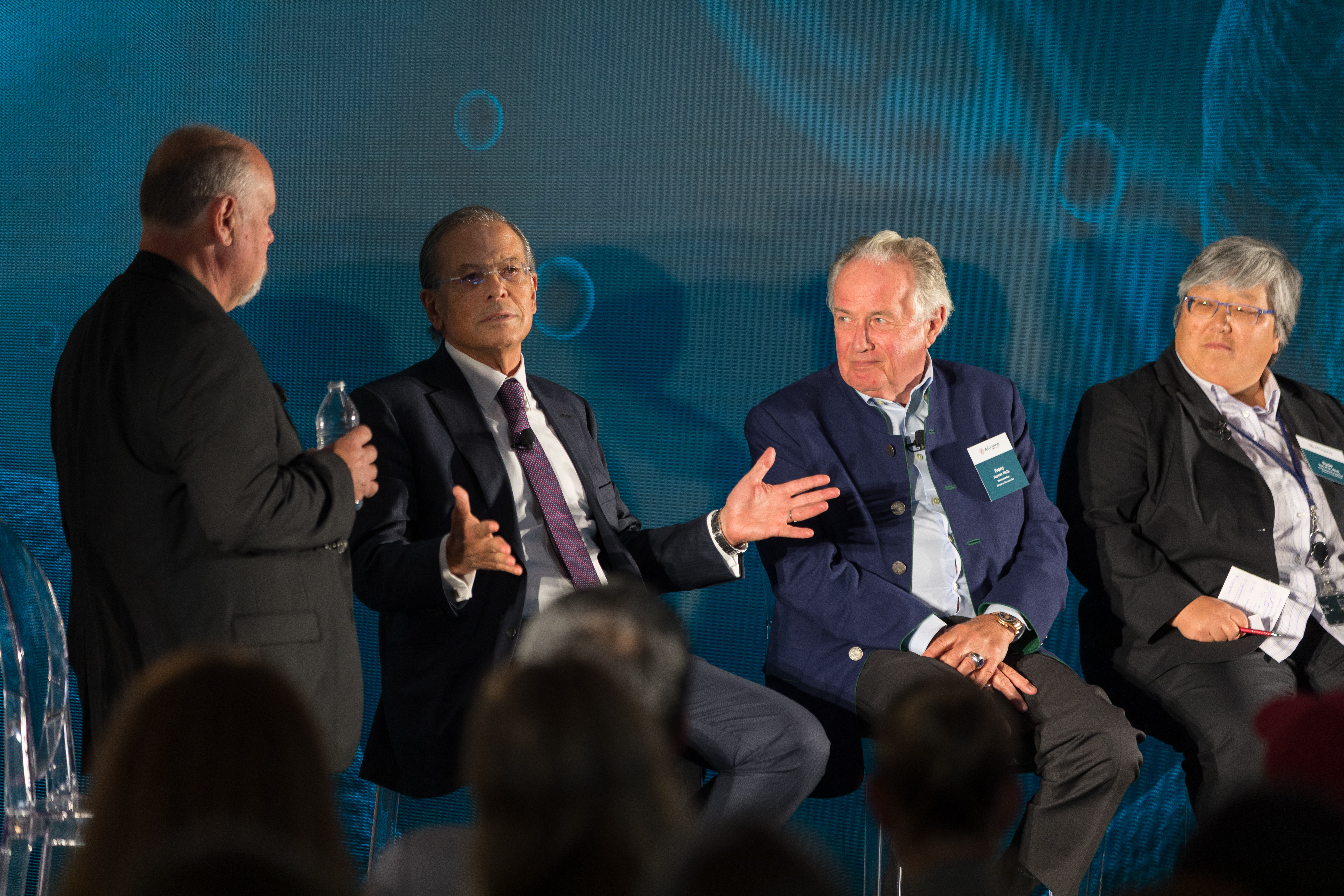 John Carroll, Arie Belldegrun, Franz Humer, Susie Jun
John Carroll, Arie Belldegrun, Franz Humer, Susie JunFive years ago was my first visit to the cFDA — the Chinese FDA. We were invited to spend about six hours with them, helping them to understand CAR T and cell therapy. Today there are over 280 clinical trials of cell therapy in China, versus 180 in the US. That is the pace of change in China, and it is just going to grow. Building Fosun- Kite PHARMA in Shanghai taught us a lot about the Chinese commitment to excellence in the Life Science. We could witness their progress and eagerness to excel at every board meeting.
So, that is the real competition we are facing today It is a whole new world and that is what keeps me worried most – losing the scientific edge and the global competition in the space.
Michael Yee: So you’ worried that innovation could decelerate and others could pass us up?
Arie Belldegrun: Oh, absolutely.
Michael Yee: Right, right. And I would, and I would argue, since we’re on a biotech 2030 panel, maybe you’ll ask for predictions, but, I guarantee that by 2030 there will be an explosion of Chinese companies and when the government-
Franz Humer: It will take another 10 years, but there will be Chinese companies with innovative medicines hitting the global market.
John Carroll: Right now the main threat, it seems to be more commoditization.
Michael Yee: Sure.
 John Carroll, Arie Belldegrun, Franz Humer, Susie Jun, Wendell Lim, Michael Yee, Ziad Bakri
John Carroll, Arie Belldegrun, Franz Humer, Susie Jun, Wendell Lim, Michael Yee, Ziad BakriFranz Humer: Every couple of years, the industry is going to disappear because of pricing regulations and changes in the regulations. I’m reasonably worried by it. If this industry continues to produce innovation that treats diseases which we are not treating, treats it in a better way, or gives people a better quality of life, we will be able to charge premium prices, will continue to be successful, because this is an industry with unlimited demand and with unlimited potential to produce innovation.
We are just scratching the surface. We’re probably two or three percent of diseases which we’re curing, the rest, we’re just treating along. Now, imagine the potential we can create. My wife died in ’99 of breast cancer. She was only treated with medicines that were available since the 1940s. If you look back today, we’d say in the ‘90s they were the Middle Ages. In 2030 to 2035 they will say about today, these guys were ignorant. That they were treating diseases like in the Middle Ages and that’s what this pace of innovation is. That’s why I’m enormously optimistic.
John Carroll: Are you optimistic?
Susie Jun: Yes. I’m very optimistic. I agree with all of them. I think that in 10 years we’ll look back and we’ll just say, wow, they were, they were so naive. They didn’t really know that the conversations were so simple and not as sophisticated and certainly without the refining definitions that we understand 10 years from now.
John Carroll: Cool. Well, I got the high sign, which says that we’re out of time. It’s been a great panel. I’d like to thank everybody here had a lot of conversation and a very interesting dialogue. Thank you very much.
Photography of Allogene HQ Open House (below) by Jeff Rumans, Endpoints News

